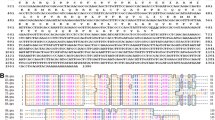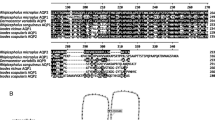Abstract
Tick proteins have been shown to be useful for the development of vaccines which reduce tick infestations. Potential tick protective antigens have been identified and characterized, in part, by use of RNA interference (RNAi). RNAi allows for analysis of gene function by characterizing the impact of loss of gene expression on tick physiology. Herein, we used RNAi in Rhipicephalus sanguineus to evaluate gene functions of two tick protective antigens, 4D8 and Rs86, the homologue of Bm86, on tick infestation, feeding and oviposition. Silencing of 4D8 alone resulted in decreased tick attachment, survival, feeding and oviposition. Although the effect of Rs86 RNAi was less pronounced, silencing of this gene also reduced tick weight and oviposition. Most notably, simultaneous silencing of 4D8 and Rs86 by RNAi resulted in a synergistic effect in which tick survival, attachment, feeding, weight and oviposition were profoundly reduced. Microscopic evaluation of tick tissues revealed that guts from dual injected ticks were distended with epithelial cells sparsely distributed along the basement membrane. These results demonstrated the synergistic effect of the silencing expression of two tick protective genes. Inclusion of multiple tick protective antigens may, therefore, enhance the efficacy of tick vaccines.



Similar content being viewed by others
References
Aljamali MN, Sauer JR, Essenberg RC (2002) RNA interference: applicability in tick research. Exp Appl Acarol 28:89–96
Aljamali MN, Bior AD, Sauer JR, Essenberg RC (2003) RNA interference in ticks: a study using histamine binding protein dsRNA in the female tick Amblyomma americanum. Insect Mol Biol 12:299–305
Almazán C, Kocan KM, Bergman DK, Garcia-Garcia JC, Blouin EF, de la Fuente J (2003a) Identification of protective antigens for the control of Ixodes scapularis infestations using cDNA expression library immunization. Vaccine 21:1492–1501
Almazán C, Kocan KM, Bergman DK, Garcia-Garcia JC, Blouin EF, de la Fuente J (2003b) Characterization of genes transcribed in an Ixodes scapularis cell line that were identified by expression library immunization and analysis of expressed sequence tags. Gene Ther Mol Biol 7:43–59
Almazán C, Blas-Machado U, Kocan KM, Yoshioka JH, Blouin EF, Mangold AJ, de la Fuente J (2005a) Characterization of three Ixodes scapularis cDNAs protective against tick infestations. Vaccine 23:4403–4416
Almazán C, Kocan KM, Blouin EF, de la Fuente J (2005b) Vaccination with recombinant tick antigens for the control of Ixodes scapularis adult infestations. Vaccine 46–47:5294–5298
Cobon GS, Moore JT, Johnston LAY, Willadsen P, Kemp DH, Sriskantha A, Riding GA, Rand KN (1996) DNA encoding a cell membrane glycoprotein of a tick gut. US Patent and Trademark Office Appl. No. 325071 435/240.2
de la Fuente J, Kocan KM (2003) Advances in the identification and characterization of protective antigens for development of recombinant vaccines against tick infestations. Expert Rev Vaccines 2:583–593
de la Fuente J, Rodríguez M, Montero C, Redondo M, García-García JC, Méndez L, Serrano E, Valdés M, Enríquez A, Canales M, Ramos E, Boué O, Machado H, Lleonart R (1999) Vaccination against ticks (Boophilus spp.): the experience with the Bm86-based vaccine Gavac. Gen Anal: Biomol Engineering 15:143–148
de la Fuente J, Almazán C, Blouin EF, Naranjo V, Kocan KM (2005) RNA interference screening in ticks for identification of protective antigens. Parasitol Res 96:137–141
García-García JC, Montero C, Redondo M, Vargas M, Canales M, Boué O, Rodríguez M, Joglar M, Machado H, González IL, Valdés M, Méndez L, de la Fuente J (2000) Control of ticks resistant to immunization with Bm86 in cattle vaccinated with the recombinant antigen Bm95 isolated from the cattle tick, Boophilus microplus. Vaccine 18:2275–2287
Karim S, Ramakrishnan VG, Tucker JS, Essenberg RC, Sauer JR (2004a) Amblyomma americanum salivary glands: double-stranded RNA-mediated gene silencing of synaptobrevin homologue and inhibition of PGE2 stimulated protein secretion. Insect Biochem Mol Biol 34:407–413
Karim S, Ramakrishnan VG, Tucker JS, Essenberg RC, Sauer JR (2004b) Amblyomma americanum salivary gland homolog of nSec1 is essential for saliva protein secretion. Biochem Biophys Res Commun 324:1256–1263
Karim S, Miller NJ, Valenzuela J, Sauer JR, Mather TN (2005) RNAi-mediated gene silencing to assess the role of synaptobrevin and cystatin in tick blood feeding. Biochem Biophys Res Commun 334:1336–1342
Kocan KM, Hair JA, Ewing SA (1980) Ultrastructure of Anaplasma marginale Theiler in Dermacentor andersoni Stiles and Dermacentor variabilis (Say). Am J Vet Res 41:1966–1976
Miyoshi T, Tsuji N, Islam MK, Kamio T, Fujisaki K (2004) Gene silencing of a cubilin-related serine proteinase from the hard tick Haemaphysalis longicornis by RNA interference. J Vet Med Sci 66:1471–1473
Narasimhan S, Montgomery RR, DePonte K, Tschudi C, Marcantonio N, Anderson JF, Sauer JR, Cappello M, Kantor FS, Fikrig E (2004) Disruption of Ixodes scapularis anticoagulation by using RNA interference. Proc Natl Acad Sci USA 101:1141–1146
Pal U, Li X, Wang T, Montgomery RR, Ramamoorthi N, Desilva AM, Bao F, Yang X, Pypaert M, Pradhan D, Kantor FS, Telford S, Anderson JF, Fikrig E (2004) TROSPA, an Ixodes scapularis receptor for Borrelia burgdorferi. Cell 119:457–468
Parola P, Raoult D (2001) Tick-borne bacterial diseases emerging in Europe. Clin Microbiol Infect 7:80–83
Peter RJ, Van den Bossche P, Penzhorn BL, Sharp B (2005) Tick, fly, and mosquito control—lessons from the past, solutions for the future. Vet Parasitol 132:205–215
Rand KN, Moore T, Sriskantha A, Spring K, Tellam R, Willadsen P, Cobon GS (1989) Cloning and expression of a protective antigen from the cattle tick Boophilus microplus. Proc Natl Acad Sci USA 86:9657–9661
Ramamoorthi N, Narasimhan S, Pal U, Bao F, Yang XF, Fish D, Anguita J, Norgard MV, Kantor FS, Anderson JF, Koski RA, Fikrig E (2005) The Lyme disease agent exploits a tick protein to infect the mammalian host. Nature 436:573–577
Richardson KC, Jarret L, Finke FH (1960) Embedding in epoxy resins for ultrathin sectioning in electron microscopy. Stain Technol 35:313–323
Soares CA, Lima CM, Dolan MC, Piesman J, Beard CB, Zeidner NS (2005) Capillary feeding of specific dsRNA induces silencing of the isac gene in nymphal Ixodes scapularis ticks. Insect Mol Biol 14:443–452
Willadsen P (2004) Anti-tick vaccines. Parasitology 129:S1–S21
Willadsen P, Smith D, Cobon G, McKenna RV (1996) Comparative vaccination of cattle against Boophilus microplus with recombinant antigen Bm86 alone or in combination with recombinant Bm91. Parasite Immunol 18:241–246
Acknowledgements
This research was supported by the Oklahoma Agricultural Experiment Station (project 1669), the Sitlington Endowed Chair for Food Animal Research (K. M. Kocan, Oklahoma State University). Consuelo Almazán was supported by Pfizer Animal Health, Kalamazoo, MI, and a grant-in-aid from the CONACYT and Promep (University of Tamaulipas), Mexico. V. Naranjo was founded by Consejería de Educación, JCCM, Spain. We thank Dollie Clawson for excellent technical assistance with the microscopy studies. These experiments comply with the current laws of the U.S.A.
Author information
Authors and Affiliations
Corresponding author
Rights and permissions
About this article
Cite this article
de la Fuente, J., Almazán, C., Naranjo, V. et al. Synergistic effect of silencing the expression of tick protective antigens 4D8 and Rs86 in Rhipicephalus sanguineus by RNA interference. Parasitol Res 99, 108–113 (2006). https://doi.org/10.1007/s00436-006-0132-0
Received:
Accepted:
Published:
Issue Date:
DOI: https://doi.org/10.1007/s00436-006-0132-0




